Written by Terry Smith
Our site is reader supported so when you click a link to Amazon we may earn an affiliate commission.
UK’s best tillers that are heavy duty TESTED: petrol, electric, and cordless
This article was last updated on April 23rd, 2022 at 6:49 am
It doesn’t matter what you’re trying to grow in your garden or on your allotment, your chances of success will be greatly increased with correct use of a tiller. But which is the best tiller for you? These fantastic tools work in much the same way as a plough, turning over and breaking up soil as they move along, and this has a ton of benefits for your plants, flowers, and crops. I took it upon myself to test a budget model for you – I appreciate unless a commercial op this will sit in the shed for a while. It was part of a wider project – whilst I made a decision on what to do with the garden I wanted to get some grass seed down for the kids – this of course mean’t I needed to turn the soil. So I decided to test the Vonhaus Tiller – it is the cheapest budget unit available at the moment, and given we only use it at home for a vegetable patch or two, it isn’t worth huge investment. I have to say the results were very impressive from my testing and as a result of the cost to performance, is my new top pick – rarely do we save money and get power.
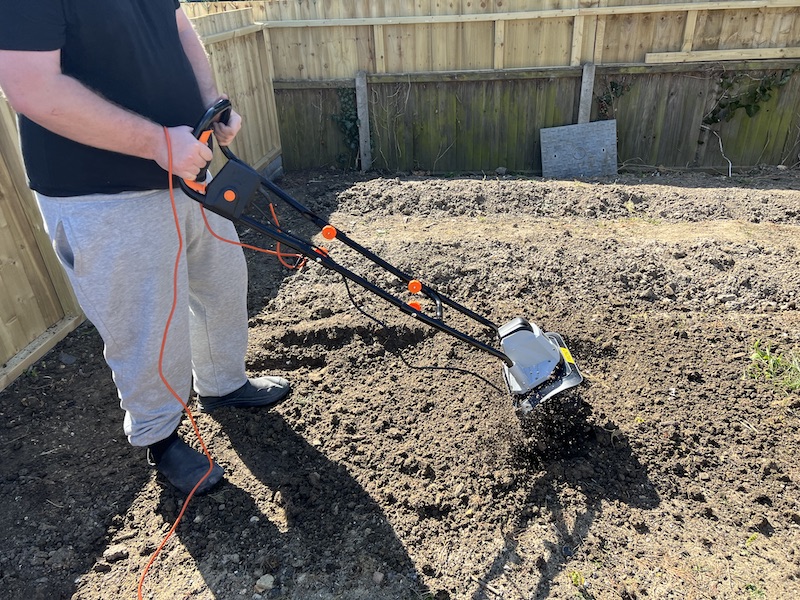
Ok, so, we’ll take a look at why you should be using one in a moment in my tiller buyers guide in more detail, but if you don’t have time for that and just want to know what products we recommend as the best tillers currently on sale, here’s a shortlist-
Best tillers: my picks after testing and using them for years:
Best Garden tiller overall- Vonhaus tiller 1050 Watt or the Garden gear 1400W tiller. Both are great all rounders – you need to decide if you need guide wheels or not.
Best electric garden tiller- Vonhaus 1400W tiller. Almost as good as the Garden Gear model, but just not quite there when it comes too thick clay soil. Better handling though.
Best cordless garden tiller- Einhell GE-CR 30. Simply the best performing cordless we tested.
Best petrol garden tiller- Mantis 4 stroke tiller. Excellent build quality for the money and a reliable Honda engine.
Best budget garden tiller- Vonhaus tiller 1050 Watt – Surprisingly good tiller for the money. or the The Handy THET compact tiller if this unit becomes unavailable.
Best heavy-duty garden tiller for hard / clay soil- Switzer heavy duty tiller. Has the build quality, power, and performance to deal with the larger, tougher jobs.
Tiller Buyer’s guide
To help guide you through the confusing ‘jungle’ of products out there, and towards the right kind of tiller for you specific needs, we have provided this little buyer’s guide that points out a few things that you might want to take on board before making a decision.
Types of garden tiller
There are three main types if garden tiller: Front tine tillers, Rear tine tillers, and Vertical line tillers. But what do they do and what are their benefits and negatives. Let’s discuss them in a bit of detail as this info will definitely impact which you select and well worth the read:
Front tine tillers
Front tine tillers like the VonHaus 1400W product, have two tines located in front of its wheels that rotate in a forward direction. You can tilt the handles backward lifting the front of the tiller when moving it around and tilt it back forward when you want to use it. Front tine tillers are usually the least powerful type but also the cheapest and are easy to find online. Here’s a look at this:
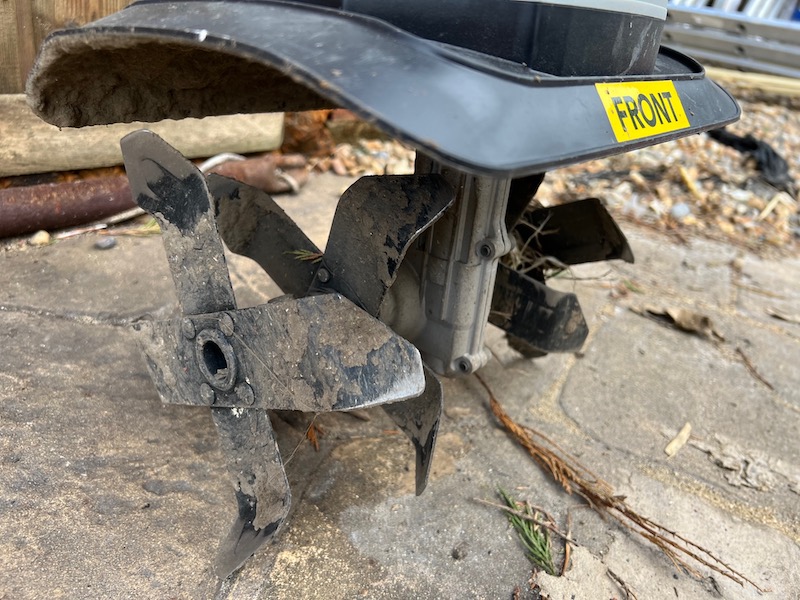
Rear tine tillers
Rear tine tillers have their blades behind the wheels and the Switzer tiller is a good example of this. They are more powerful and dig deeper than front tine tillers. Different models of these tillers have blades that rotate in various directions. Some rotate forward like the front tine tiller, some in opposite directions. Rear tine tillers are better for tackling tough soil and breaking new ground.
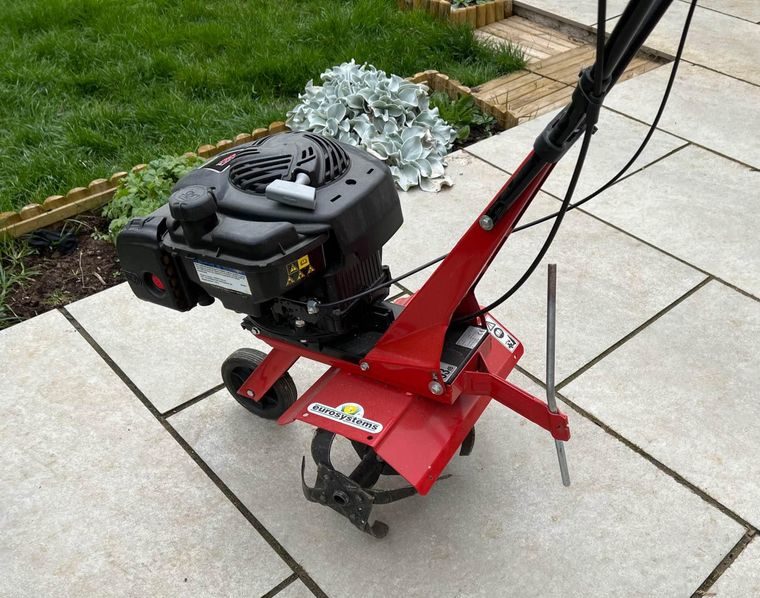
Vertical line tillers
Vertical line tillers are the most recent and least common type of tiller out there. They differ from the others in that the tines cut forward instead of downward making them more efficient, but they aren’t as common as the other two types of tillers.
The type of tiller you will need is dependent on a host of factors such as garden size, soil type, how deep you want to dig, and of course your budget as the price range is quite wide. You should also consider things like maintenance costs, what special features would be helpful for you, and your available storage space.
Here’s a video you might be interested in that goes into more detail about the different types of tillers available. It’s an American video, but the information is still useful to UK gardeners:
Electric, cordless, or petrol tiller?
As well as these three different types to choose from, you also have to decide upon either an electric, cordless, or petrol tiller. Each of these has its pros and cons, but I’ll just do a quick summary here for you-
Electric tillers
The most common type of tiller and generally the least expensive. These machines are easy to set up and operate, and require very little maintenance, making them great for casual gardeners with small to medium sized gardens.
The biggest flaw of their design is that your range will be dictated by the length of the power cable unless you use an extension lead, so this is something to check before buying and you want at least 10 metres such as the cables found on my Vonhaus tiller 1050 Watt and Garder Gear tillers. On the plus side though, you’ll never run out of fuel unless there is a power cut in your area.
Cordless tillers
The main advantage of cordless models over corded electric is that they give you more freedom of movement and range, and you don’t have to worry about accidentally treading on, or cutting through, a trailing power cable.
On the other side of the coin, is the fact that the batteries fuelling these machines will probably only get you about 30-45 minutes of use before they need charging again, and buying replacement or spare batteries can be expensive. So, it’s important to know the charging time to working time ratio when purchasing a cordless tiller, and I wouldn’t recommend them for larger gardens. There are some new products that can go for longer than 45 minutes at a time, but you’ll have to buy the largest batteries to get that out of them. The Einhell cordless tiller is just such a product.
Petrol tillers
Easily the most powerful type you can buy, especially ones with large engines like the Switzer, petrol tillers will break hard ground much easier than both electric and cordless models. A full tank of petrol will certainly last longer than a full lithium-ion battery too, but obviously can’t compare to being connected to the mains by a power cable. Not all petrol tillers have the same size tanks though, so this is something to check.

Petrol tillers have the highest running costs, and are usually the most expensive to buy too. You have to factor in the price of petrol, as well as changing things like spark plugs, engine oil, etc. and the time taken to maintain these machines. Unless you really feel you need the extra power, or have a large property to cover, you might be better off with an electric tiller, although the Mantis petrol tiller is a good option too due to its smaller dimensions.
Hand powered tillers
These traditional tools aren’t really used that much anymore as the price of electric tillers has come down so much and its hard to justify paying not much less for a hand tiller and then having to do all the work too!
Where these tools can come in handy tough, is to turn over soil in your beds and other small areas where it is difficult to use a larger tiller, so it might pay to have one lying around. Tillers like the one in the photo can be found for fairly cheap prices, so why not invest in one?
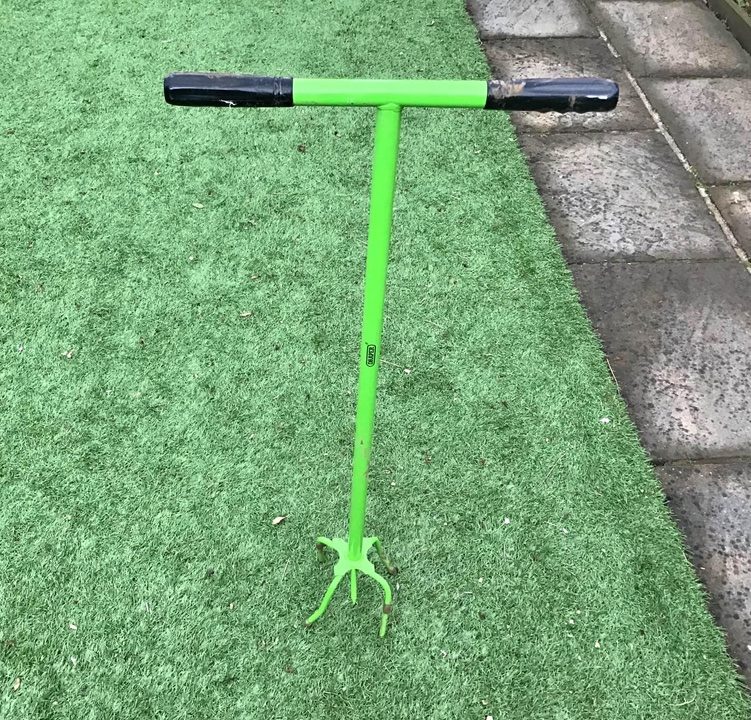
Engine power
We already compared electric, cordless, and petrol tillers for power in the previous section, but a quick look on Amazon will show you that there are differences in power between various models in the same sub-category.
If you’re shopping for a corded electric tiller, then I would suggest you find one that is at least 750 watts, even for a small garden. Medium sized properties, or for dealing with thicker or harder soil will probably require you go up from there in the power stakes and buy something between 1000w and 2000w.
The power of a cordless tiller will be affected by how many batteries it runs off and how large those batteries are. There are other factors too, such as the design of a particular product, but battery size is a good indication to go by. Also, please bear in mind that the more powerful cordless tillers are likely to use up batteries faster than lesser powered models.
Petrol powered tillers run off small engines, usually starting around 25cc but larger models can have much more powerful engines than that. To be honest, a 25cc petrol tiller should provide easily enough power for most people and only a small percentage will need something bigger.
Sometimes a product is advertised with the horsepower output or even kilowatts. 1-3 HP is more than adequate for home gardening, as is anything over 1kw. The Switzer heavy duty tiller has a whopping 6.5HP and the tiller in the image below is around 5HP, which is overkill for most people.
Heavy duty petrol rotovator tiller
Size
One thing that people tend to overlook when buying a garden tiller is the actual dimensions of the machine, and then they end up struggling to find space in the garage or shed in which to store it.
These days, most tillers will come with foldable handles, which is a big help, and some have even more parts that can be removed or folded to make the tiller smaller. Of course, this means you have to spend more time setting the machine up and packing it down after each use, but as long as the design has been done well, it shouldn’t take more than a few seconds.
The Handy electric tiller is a great choice for people looking for a practical but compact tiller. It’s lightweight and won’t take up much space in the shed, but has a build quality and performance that outshines the vast majority of cordless versions.
Weight
Yet another very important factor is weight. Some of these machines can be quite heavy, especially petrol tillers, and you will have to move that weight over soft ground, so choose carefully. The Mantis tiller is lighter than many petrol models, but still much heavier than electric and cordless models such as the VonHaus tiller and the Einhell cordless tiller.
Some models will have some kind of ‘auto-drive’ where the machine will pull itself forward via powered wheels, but this feature usually means a higher price tag and if that pull is a bit too powerful, and you’re of smaller stature, it might end up running away from you.
On the other hand, a tiller that is too light will not dig sown into the soil well, and will require a lot of work from you to push it down, especially in thick soil. This can get very tiring after only a short time, so choose carefully. The plus side to lighter tillers, is that they are more manoeuvrable, which might suit people with small or uniquely shaped gardens.
The Gardenline tiller in this photo is a good idea of a compact and lightweight garden tiller, and has dimensions similar to The Handy tiller from our reviews-
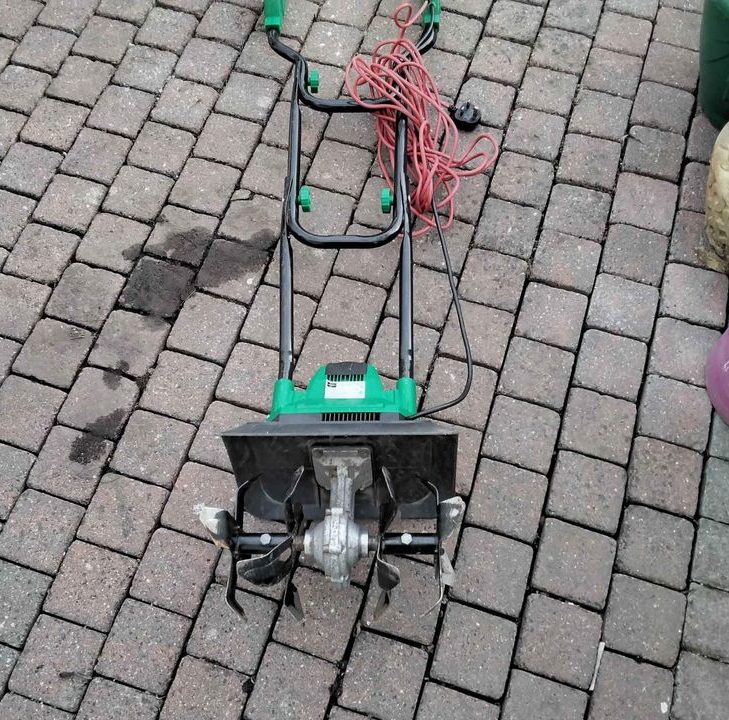
Tines: length and width
The length of the tines on a tiller will tell you how deep it can possibly dig into the soil. Depending on whether a machine is a front or rear tine tiller, practical tiller length should be between 6 and 12 inches, but there are models out there that allow you to adjust the depth at which the tiller will dig.
How wide an area a tiller can cover at once is not a universal thing, and can actually vary significantly from one product to another. The main thing to know is that narrower tillers with tine coverage of between 10 and 14 inches will be easier to move and turn around, while wider tillers will allow you to get the job done much faster but might be quite a bit harder to manoeuvre.
Wheels and Tyres
As a stationary tiller is fairly useless, the wheels and tyres on these tools are very important and should not be overlooked as part of your buying decision. There are some tillers that don’t have wheels at all, The Handy tiller for example, but these are usually compact and lightweight models with less power.
It’s not just the size of the wheels that’s important either, although that is certainly something to look at. Just as important are what kind of wheels they are and whether or not they have tyres.
Plastic wheels are very durable, but they can sometimes struggle to move over soft and damp soil unless they have a good tread on them for grip and are an adequate size for the machine, which they often aren’t as you can see here:
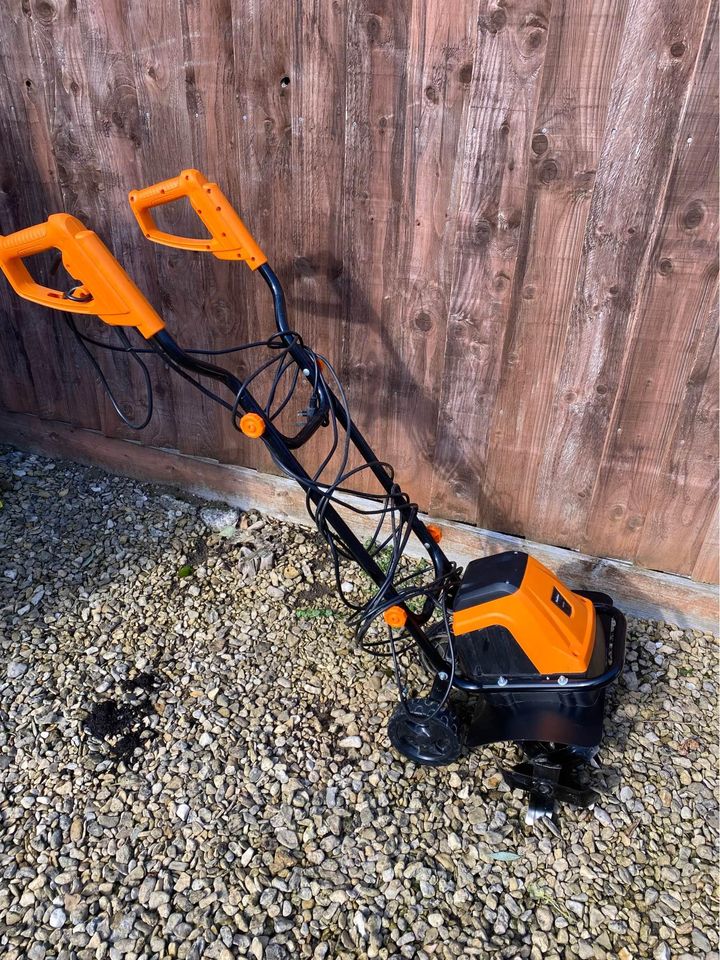
Pneumatic tyres, like the ones found on our featured petrol tillers, are filled with air and offer much better grip on the soil than plastic wheels and offer more resistance to shock. The downside to pneumatic tyres, as anyone who’s ever owned a bicycle or car will tell you, is that you will inevitably get a puncture at some point.
What are tillers good for?
For a start, if your soil is densely packed together, you’re going to have problems growing anything at all as water and oxygen won’t seep through to the roots properly. Obviously, if the water isn’t penetrating the surface, it is likely pooling up and this can lead to a whole list of problems on its own and is best avoided.
Not only will there be problems with nutrients flowing down from the surface when your soil is too dense, the plants themselves will seriously struggle to move up through it or to spread their roots, giving them little chance to get established. Thick clay soil is the worst culprit for this, and not all tilers will deal with clay that well, so go for a petrol model like the Mantis tiler, or a proven electric tiller like the Garden Gear product.
Turning over your soil occasionally is something that is recommended by the majority of experienced gardeners. You see, the top soil in your garden will become less nutrient rich and fertile over time just through being exposed to UV and other natural phenomena, but the deeper soil will be in much better condition. So, using a tiller is a great way of bringing that up to the surface where it is needed.
Another excellent advantage of using a tiller to turn over your soil is that you can get at the roots of weeds. When you just pull weeds out from the surface, you are usually just delaying the inevitable as they will grow back. But if you get rid of the roots, you will no longer be fighting a losing battle. Having said that, if you have very stringy and tough weeds infesting your soil, there’s a chance that lower powered tillers, like the cordless Einhell product we feature, or the type featured in this photo might have problems with the weeds getting stuck in the blades.-
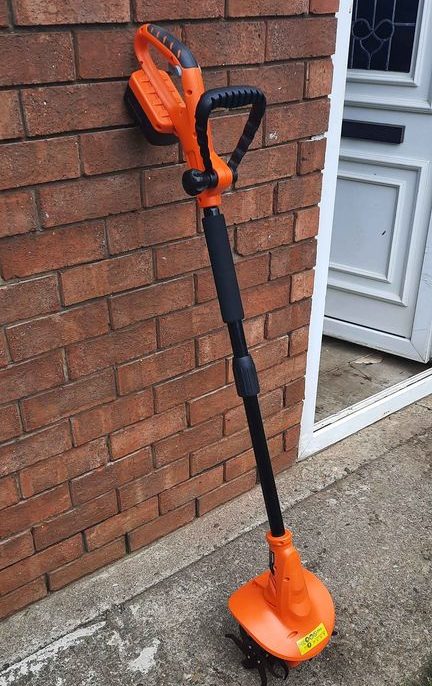
Tilling is a fantastic way of adding nutrients to your soil through the use of compost, manure, etc. Simply till the soil first, add whatever you need to add, and then turn over the soil a second time, and you’re golden.
When is the best time for tilling my garden?
I think most people would agree that Autumn and Spring are both good times for tilling, but if I had to choose just one of those, I would go with Autumn. This is because you can take advantage of the natural life cycle of plants, trees, and even weeds by turning their dead remnants over with the soil and allowing them to break down into helpful nutrients.
Spring tilling is also very helpful, but you have to get the timing right. If the weather is still too cold, as it often is in very early spring, you shouldn’t be tilling your soil. A minimum of 16 degrees Celsius is required for effective tilling. Even if you have a powerful tiller like the Switzer 6.5 horsepower model that can easily break up the soil, it is still better to wait for the right conditions for a number of reasons.
If you do intend on tilling in spring, you should do it a few weeks ahead of your planting schedule as the microorganisms will need that long to recover and settle after the process.
Another thing to keep in mind, for any time of the year, is to avoid tilling when the soil is wet. Moist is good, wet is not. Tilling wet soil will likely cause the soil to clump together and this will just cause problems when it eventually dries out. It’s fine to sprinkle a little water from the hose to make dry soil easier to deal with, but if it’s been raining heavily in the past 48 hours, you should leave it a bit longer.
The following clip talks about how to test your soil before tilling, so if you’ve never done it before, you should give it a watch:
1. VonHaus Electric Tiller 1050W – Garden Soil Cultivator/Rotavator
Let’s start with what I absolutely hate – and it’s just one problem on an otherwise faultless performance and test. The safety button to engage the trigger has to be about the worst position / design I have ever seen. As a strong man this still requires me to perform a two handed operation to release the safety – which means a difficult and careful balance act to maintain the control of the tiller. Watch the video to understand what I mean if that’s not clear, but other than that this unit is nothing but great news:
Right out the box it’s pretty easy to see what’s going on, you’ve got 4 hand bolts that tighten together easily to make the frame, the electric control section screws to this and because of the holes in the metal it is painfully obvious how to put this together. Then it’s a simple case of screwing the handle to the unit. Here’s a really quick rundown:
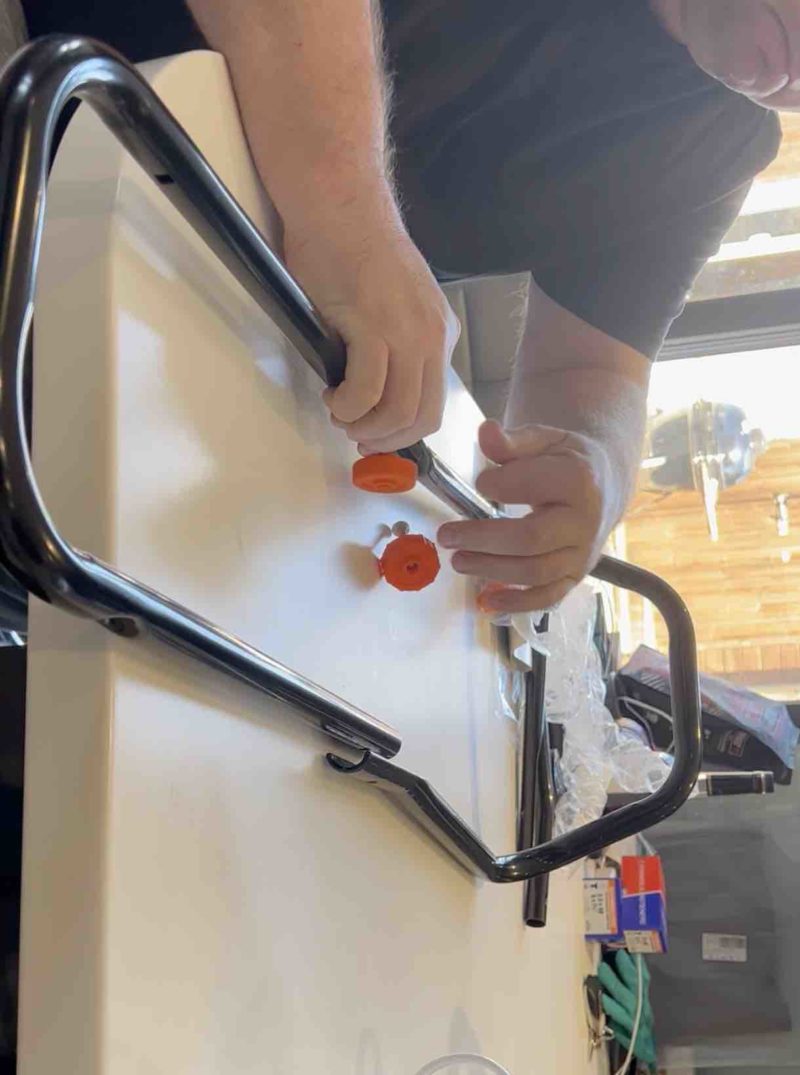
Then you extend the frame with the same bolts:
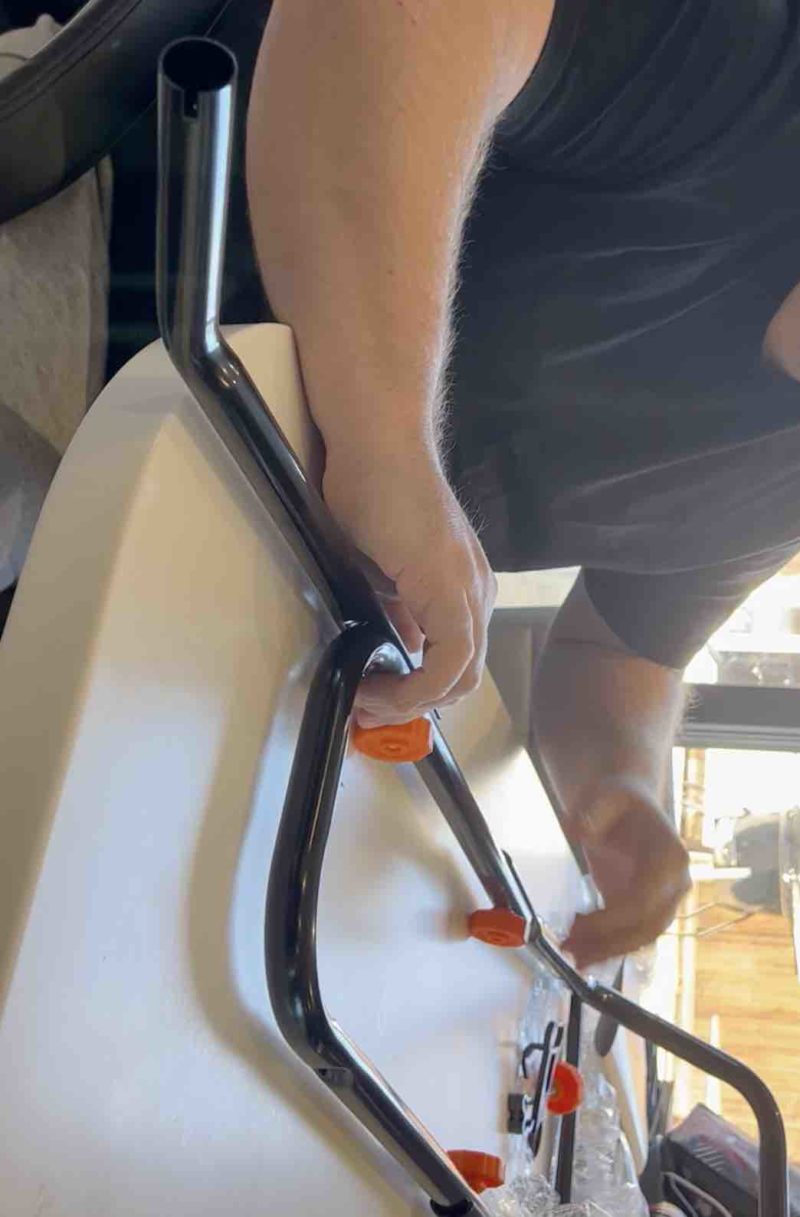
Then it’s a simple case of screwing that frame you’ve made to the unit and it just slots and screws in – there really is nothing to this:
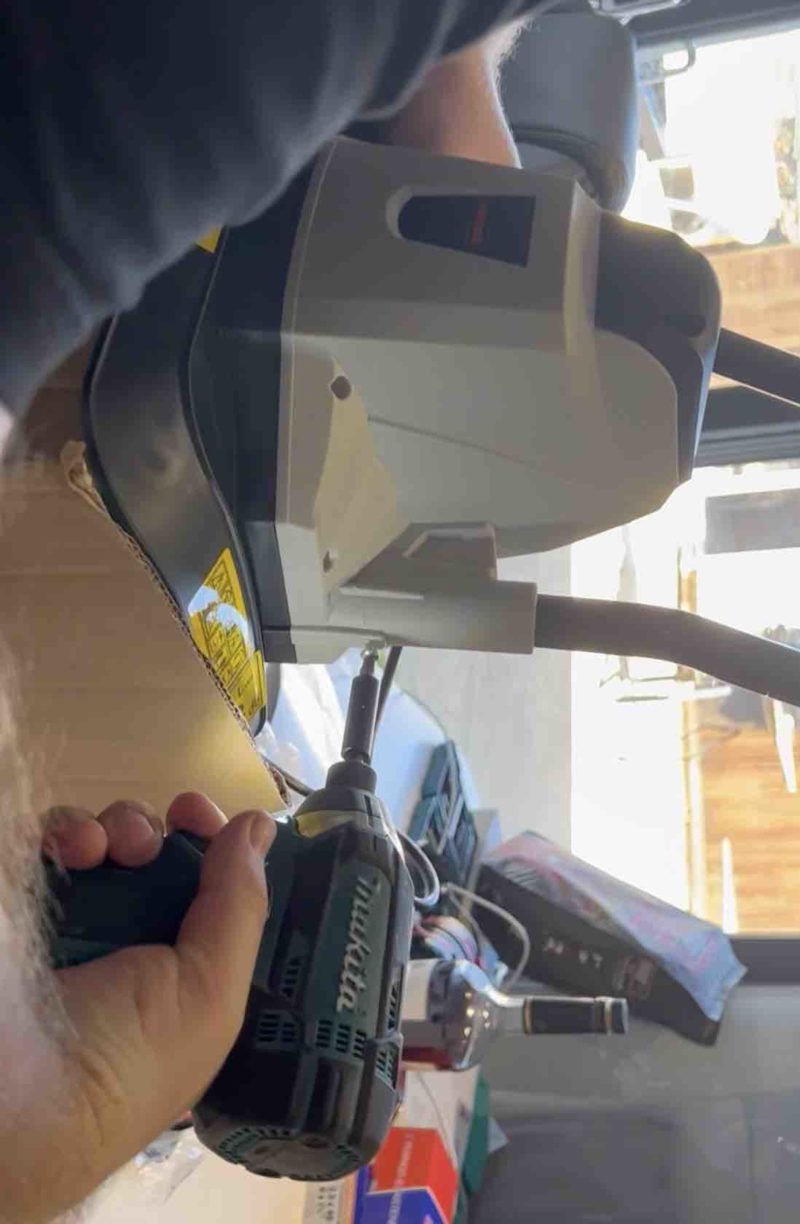
Then you simply fit the electrical unit that is guided with holes in the metal frame – you cannot get this wrong:
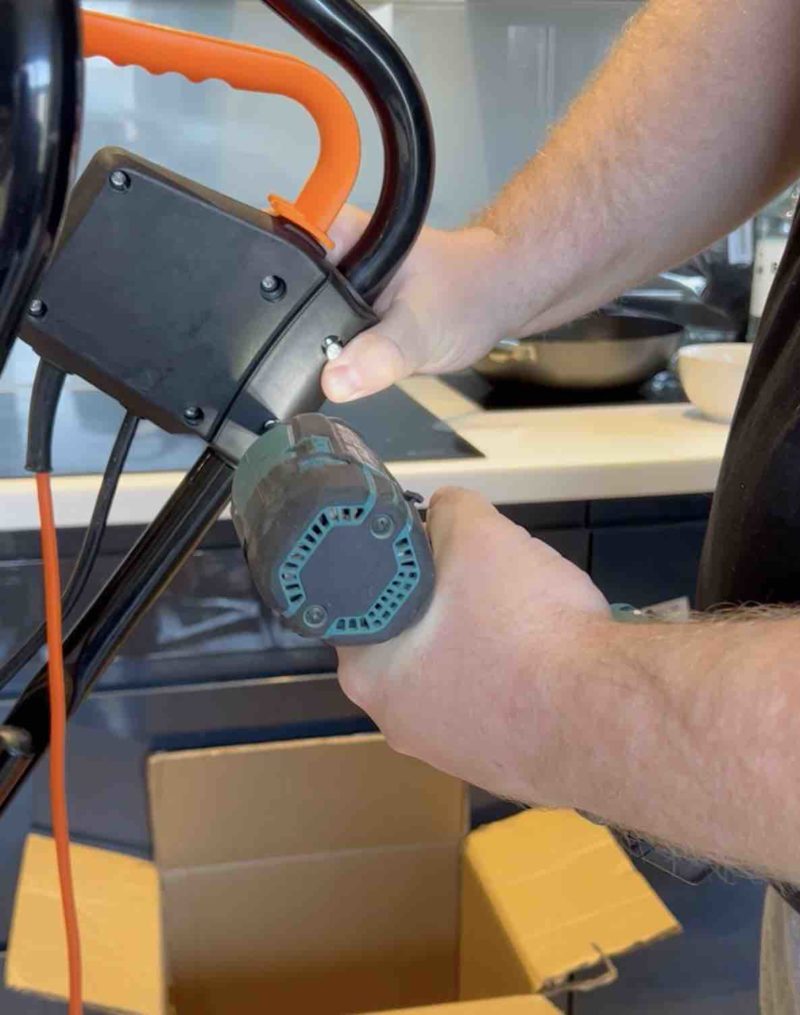
That’s it, you’re literally ready to go. I would put assembly time at no more than 5 minutes and most of that is familiarising yourself with the parts – no need for a cordless drill either – you could easily use a hand screwdriver to screw the switch on and handle to motor unit.
The first thing you realise if you have a garden of any size – you need an extension lead. I personally use my cable reel extension as the garden is a fair way from power. It also provides for much more freedom of the power lead on the tiller itself:
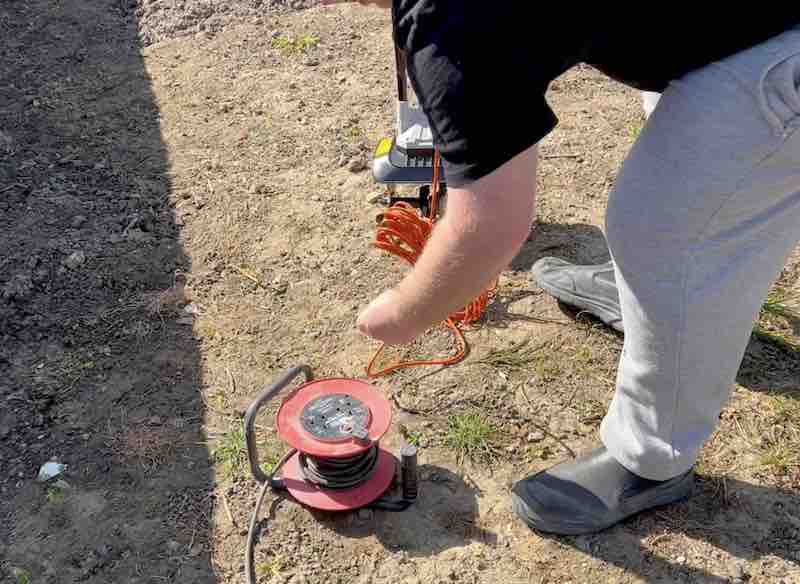
Now it’s time to turn the unit on – you’re going to struggle to release the safety and engage the motor – unless you’ve got 3 hands! However once engaged the performance will shock you for a budget unit. It is easily as good as the previous Garden Gear tiller I had top pick that I tested in terms of ability to break up clods. I would say though, on dense material, especially clay, pulling in reverse is far more effective. I have to say I thought I would miss not having wheels as guides – how wrong I was I actually preferred the experience and use.
And talking about effective – the first thing this unit is going to do is bounce like crazy – initially you think it’s the machine is rubbish – until you change to a more shallow angle and everything starts to click into place and you start realising just how accomplished this unit really is. Here’s a look at the performance – it’s much better articulated as a short video:
So as you can see the bounce is entirely due to the angle of use, if you’re vertical it’ll bounce it’s as simple as that – you need to be as low to the ground as possible, with the mud guard at the rear basically touching the ground, that’s how I found to operate this best in testing.
As for power, I turned over an 8m by 16m area in about 4-5 hours. Given it was grass I could have gone less deep – you’ll notice it’s bare earth no doubt. This is because I ran several weed killer tests before and completely cleared the area – this makes your tiller far more effective. To achieve that level of clear took about 6 weeks from the point of application. I will also say this – I wen’t at this non stop with only a beer in between whilst I had a breather. The unit wasn’t stressed or overly hot at any point – I dare say it could handle much more, but I couldn’t that was a thorough workout holding onto that machine. In terms of energy required I found my hands locking before tiring. If you go at this piecemeal you won’t have any problems at all. I’ve tested it as hard as I could and there was no break at all. Well built and decent unit. I did notice I had to tighten a bolt though, that was the grand sum of failures.
I managed to keep the unit pretty straight on long ish lines too:
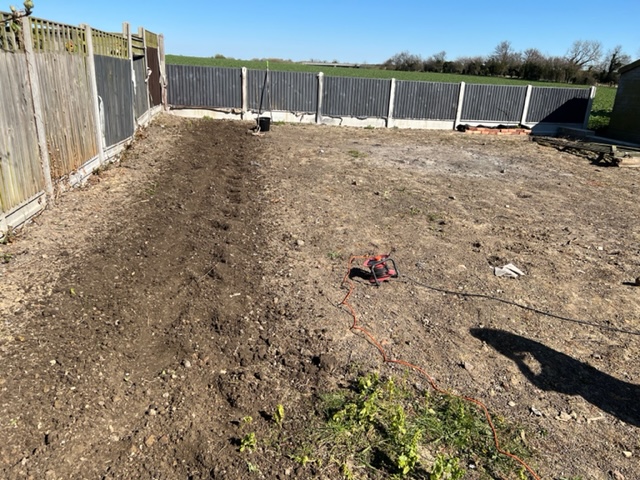
Here’s the whole area finished after about 4-5 hours total:
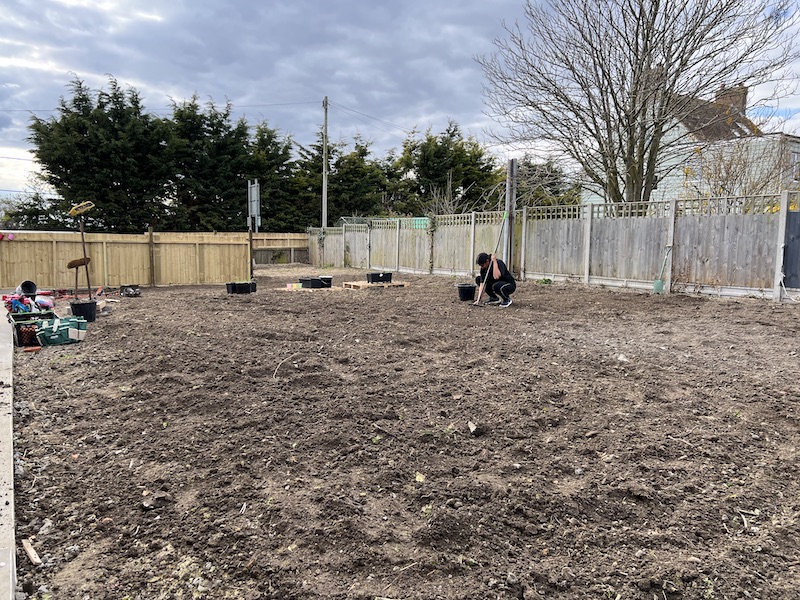
I have to say, if you’re planning to do the odd vegetable patch or three, then this is an absolute steal. I don’t rate the safety switch much as I say, but apart from that I really like it. I even hit many half bricks and stones (just did a major landscape jobby and built a retaining wall). And it didn’t damage the unit at all but you can definitely see the battle scars:
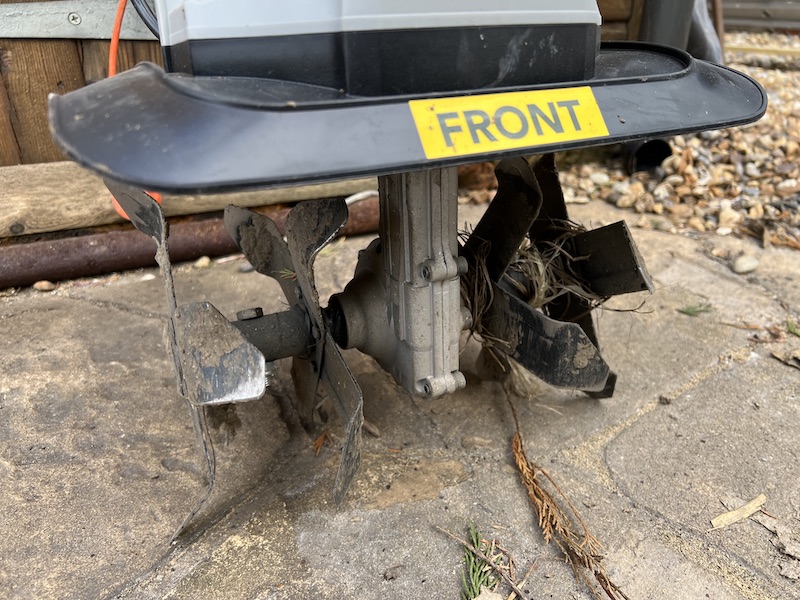
I’ll give this a 10/10 for price, 1/10 for safety switch, 9/10 for power, and 7/10 for usability, this is all compared to my previous knowledge of testing other electric tillers and using many petrol tillers with far more power. In short, it’s a rough and ready to use machine with loads of power and a real bargain.
2. Garden Gear Electric Garden Tiller, Cultivator & Rotavator
The Garden Gear electric garden tiller is for sale at , and with that price you get a 2-year guarantee. Whats more, a powerful 1400-watt electric motor drives the 6 tines at 380 rpm, making light work of tilling tough soil, clearing weeds, digging holes and much more – here’s a little look at the demo before we get into the nitty gritty:
The tines are built to last and are made of hard-wearing material. They can cultivate up to 22cm deep and 40cm wide which makes it handy for getting into harder to reach areas that larger tillers can’t.
At just over 12 kilograms in weight, this electric tiller won’t be breaking your back anytime soon. Being fitted with plastic wheels it is easy to move around by simply tilting it back. This lifts the blades of the tiller out of the ground at the same time.
This electric tiller has a couple of safety features, such as a 2-point safety switch which brings the tines to a dead stop the moment you release the trigger, and an overheat protection system to protect the motor.
My initial observations on the build quality are that it is good and robust enough to last a fair while.
The Garden Gear electric tiller comes partly assembled to make setting up easier and faster and the 10 metre long power cable included in the box should give enough length from the power socket for most people.
Garden Gear’s 1400-watt electric tiller is a great bit of kit at a very reasonable price. I couldn’t find much to fault it on except for the small wheels.
Pros
- Very powerful 1400W motor
- Can handle tough soil and clay
- Great safety features that work just as they should
- Lightweight and easy to move around
- 6 tines are made of good quality materials
Cons
- No variable speed controls
3. VonHaus Electric 1400W Tiller - Garden Soil Cultivator/Rotavator With 6 Blades – 40cm Cutting Width
Well-known Brand VonHaus bring us a product which on paper is almost identical to the Garden Gear electric tiller we just reviewed, albeit for a slightly higher price but offers decent power – take a look at this example test use:
Just Like the Garden Gear tiller, the VonHaus is powered by a 1400-watt electrical motor, but has a lower RPM of 280 and this can be noticed under certain circumstances, which we’ll get into in a moment but first here’s a look – it’s a sensible enough design:
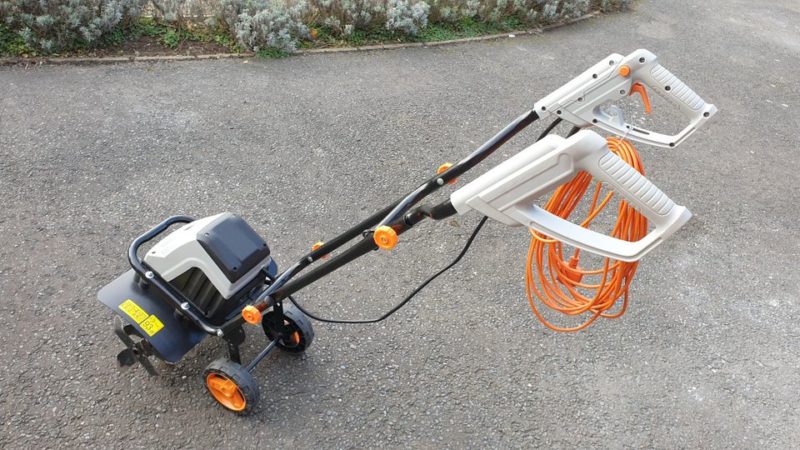
The Von Haus also has 6 blades and the cutting width and depth is the same as our previous review- 40cm wide and 22cm deep. Even the wheels are a similar size and design, which in my opinion isn’t exactly a good thing, but they do what they’re intended to.
This product is powerful and performs well on most soil, but I found that for clay, the garden needed to be prepped a little beforehand or it wouldn’t work as efficiently as designed, and in this category it falls short of the Garden Gear model.
It weighs a kilogram less than its rival at only 11kg and is very easy to set up, so you should be up and tilling in about 5 minutes. Manoeuvrability is on point too, despite the small wheels, and I did feel like it was easier to get around the garden than its closest rival. Please be careful when starting this tiller up though, as like the other 2 electric models we reviewed, there is no power control and it comes on very quickly
The VonHaus 1400W electric tiller offers the same safety features too, namely a safety shut off switch and a thermal protection system to shut down the motor if it senses that the temperature is too high. All fairly standard these days, but still good to have.
This electric tiller comes with a 10 metre long power cord and a 2 year warranty, again fairly standard but not to be sniffed at, and that cord should be long enough to get you to the bottom of most gardens.
I guess I’d sum up the VonHaus 1400W electric tiller as being a very good product for the money you pay for it, and is extremely similar to the Garden Gear model. It doesn’t handle clay soil as well as its rival, but still has plenty of power, and it did feel more manoeuvrable to me.
Pros
- Plenty of power available from the 1400W motor
- Solidly built with high quality plastics
- Lightweight and manoeuvrable
- Easy to set up
- Safety shut off kicks in quickly
Cons
- Doesn’t handle clay soil as well as the Garden Gear tiller
4. The Handy THET Electric Compact Tiller Cultivator
At its current price this electric garden tiller, brought to us by its makers ‘The Handy’, gives you excellent value for money – if you don’t know this maker, you should, they make superb electric log splitters – proven electric motor quality that I’ve tested there. This electric garden tiller is perfect for prepping small to medium sized flower beds and vegetable patches, and works to a maximum depth of 20cm and a width of 30cm. For most average sized gardens, this is enough to keep you happy.
The blades are powered by an 800-watt electric motor that does a good job of providing enough power to till heavy soil without too much bother. Now, it can’t match up to either the Garden Gear or VonHaus tillers’ 1400W motors, but it isn’t no slouch.
Please bear in mind that despite this electric tiller performing well, it isn’t a heavy duty, industrial model, like the Switzer or Mantis tillers, so you will have to remove any large stones out of its path or the blades could get jammed, or maybe see the stone flying out and potentially causing injury. Saying that, it doesn’t seem to have any problems with shifting very small stones.
It’s clear to me that The Handy electric garden tiller has been made to be used by everyone, including people with no experience. Setting the tiller up is as simple as attaching the handles and securing the wires. This can be done with minimal effort with only a screwdriver and spanner.
There is a thermal protection feature, where the machine detects when the motor is under too much strain and overheating and switch itself off. It’s very easy to get a stone stuck in the blade and not realise that it is jamming it. This feature prevents that from happening and will prolong the working life of the motor.
The Handy is a durable little fellah too. For these tests, we borrowed my neighbour’s tiller that has seen a good few years’ worth of use, and it was still working fine despite looking a little dated as you can see in the image below:
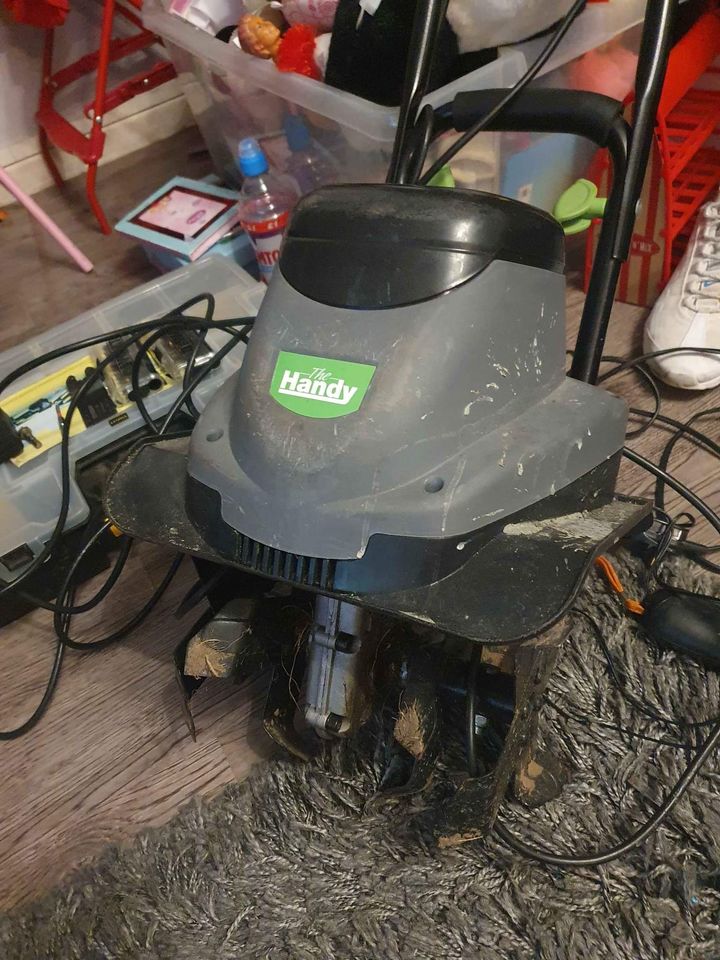
Despite not having any wheels, moving this product around won’t cause any problems for anyone as it only weighs 9.7 kilograms. Easy storage is helped along by the compact design and also the foldable handles.
The one thing I will say that this electric tiller needs is a way to come on the power gradually. As it is now, the power comes on suddenly and can catch you by surprise the first time.
If you’re looking for a well performing, electric tiller for an average sized garden that won’t leave you bankrupt, The Handy Electric Garden Tiller is for you. It would have been nice if it was fitted with wheels but it is very lightweight and gets around easily enough
Pros
- Well-built considering the low price
- Overheat feature will protect the motor and improve longevity
- 800W motor delivers enough power for most small and medium sized gardens
- Easy to set up and maintain
- Foldable handles for easy storage
Cons
- Power comes on very suddenly
5. Mantis 7263-12-14 Stroke Classic Petrol Tiller
Mantis is one of, if not the most, well known and popular brands out there. They have a wide range of best-selling products and are renowned for the build quality of their products. Here’s a look at their demo video:
This particular model is aimed at people who still want the lightweight manoeuvrability of a compact electrical tiller such as the one from ‘The Handy’ but with the power that only comes from a petrol engine tiller.
The compact design of this petrol tiller means it can be used in narrow spaces and its 9cm cutting width is perfect for those with raised beds and patches. Still, its powerful 25cc Honda engine allows you to till a larger area of garden if need be.
This Mantis petrol tiller is a great little performer and can dig down up to 10 inches even through hard clay, and if you are looking to shallow cultivate, you can reverse the tines and it will till up to 3 inches deep. This is perfect for getting rid of stubborn weeds.
The tines themselves are extremely robust and Mantis is offering a lifetime guarantee on them breaking. There is also a 5 year consumer guarantee on the petrol tiller as a whole, something you don’t really get when you buy an electric or cordless model like the VonHaus or Garden Gear tillers.
The box contains everything you need to get started
- 1 x Classic Mantis 4-Stroke Tiller
- 1 x Owner’s Manual
- 1 x Bottle of 4-Stroke Engine Oil
- 1 x Set of Digging Tines
- 1 x Hardware Bag
- 1 x Kickstand Attachment
The only thing I didn’t like about this petrol tiller is the inevitable noise, but that is to be expected with any petrol-powered gardening product and a pair of ear protectors solves the problem.
You also have to be careful with hard roots as they will jam the blades, although this isn’t as big an issue as it is for electric tillers, it is still something to avoid. This is a powerful little tiller, but it’s not up to the raw performance standards of the Switzer heavy duty model.
This petrol garden tiller is designed for small to medium garden use, hence its compact and lightweight design that you can see for yourself:
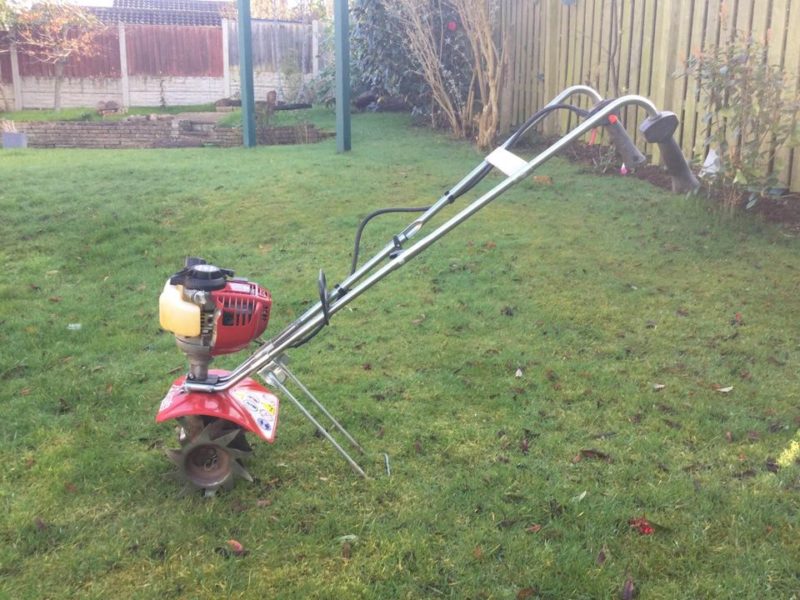
Priced at £391.95, it is far more expensive than a lot of electrical models of the same size but this petrol tiller offers much better performance and build quality.
Pros
- Extremely well-built and durable
- Robust blades with a lifetime guarantee
- Reversible tines for Shallow cultivation and weeding
- Compact and lightweight for a petrol tiller
- High quality and reliable Honda engine
Cons
- Like most petrol tillers it is noisy
6. SwitZer Heavy Duty 7 HP Portable Petrol Garden Cultivator Rotovator Tiller
Have a larger garden than average and need to turn over a lot of soil in the shortest time possible? This is the machine for the job. It isn’t the cheapest tiller out there, but it does deliver performance that is hard to beat, and certainly not matched by any of our other featured tillers. Check out the heavy duty Switzer in all its glory and power:
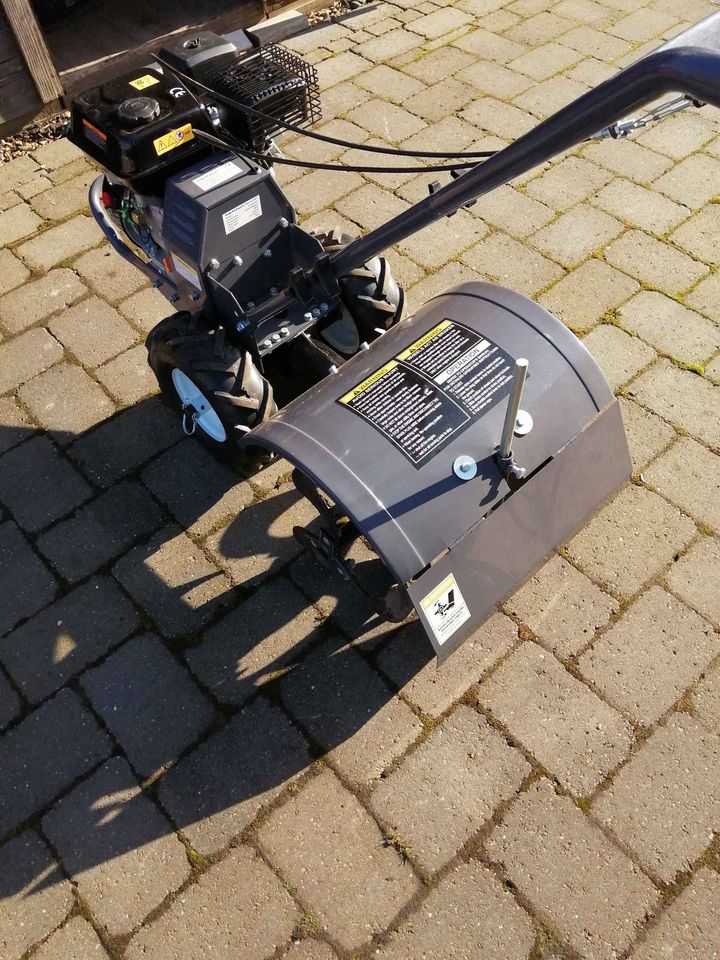
The Switzer petrol tiller’s robust frame houses a 6.5 horsepower, 196cc 4 stroke OHV engine, giving more power than most people will ever need for their garden duties, but that’s no reason not to want it, right?
That extra power does come in handy though, especially when dealing with the heaviest soils and clay. While most electric tillers struggle with these conditions, and this is certainly true of the VonHaus tiller, the Switzer doesn’t even seem to notice and will even till soil that is full of stones of all sizes.
It’s not only power that you get for the extra money either. There are all sorts of nice features on this heavy-duty tiller. Take for example, the adjustable depth regulator that gives you excellent control over how deep you want to till, or the fact that it has three gears- forward, back and neutral. Those gears will come in handy to move the 76kg weight of the tool around, believe me.
I do have to say that the controls for changing the gears should have been made more convenient to use. Instead of simply having them on the handle bars for quick changes, they are actually located on the front of the tool which is hardly the best design.
This machine has been built to last, with a copper gear drive transmission, solidly built tines, and a heavy-duty metal frame with good quality powder coating. There are a couple of plastic parts on there that I would like to see replaced with metal, or even higher-grade plastic, but they are few and far between so I can’t grumble too much.
As mentioned above, at 76kg this isn’t the lightest tiller available, but thankfully there are two large, pneumatic tyres that do a fantastic job of helping with the load. The treads on the tyres grip even the wettest and softest sol well, and overall, the tool is not too hard to move around.
Being a petrol machine, you do have to accept the fact that there will be far more noise and vibration than with any electric tiller. The vibrations that the Switzer produces are very noticeable, and you would e advised to keep tightening up the nuts and bolts before and after each session.
Pros
- Large and well-built machine for heavy duty work
- Very powerful 196cc four-stroke engine
- Forward, neutral, and reverse gears
- Copper gear drive transmission
- Excellent pneumatic tyres
Cons
- Awkwardly located transmission controls
7. Einhell GE-CR 30 Li-Solo Power X-Change Cordless Tiller
Most cordless tillers only have enough power to handle the lightest garden tasks, such as tilling small flower beds, but the Einhell GE-CR 30 breaks the mould and gives you a lightweight, highly mobile, tiller that can do a fair bit more.
Don’t get me wrong, it is still a cordless machine and therefore has its limits, and it wouldn’t be fair to expect the same performance as from any of the corded electric tillers we have featured in this article, but it is definitely a step in the right direction for this type of machine.
The reason the Einhell is able to outperform most of the other cordless tillers is that it runs off two 18V batteries. These batteries, plus the charger have to be bought separately though, so please factor the price of them in if you’re thinking of buying.
The Einhell li-ion batteries come in various sizes ranging from the smallest 2.5Ah that will give you around 15-20 minutes of tilling time, to the largest size of 6Ah, which should give you closer to an hour of use between charges.
This is a great tool for allotments or vegetable patches at home, and will let you dig down up to 20cm in most soil conditions, but thick clay soil will slow things down a fair bit and some long plants can get wrapped and tangled up in the blade from time to time, so you’d be best getting rid of those before tilling.
The biggest issue I have with the Einhell GE-CR 30 is the same one I have with so many tillers, lawnmowers, and other gardening power tools- the wheels. It just frustrates me that the designers of these products don’t seem to take into account that you have to move them around, and that those wheels have to last as long as the tool itself!
Actually, apart from the wheels being a bit on the small side and plastic, they aren’t that bad, it’s the fact that they are only held in place by a single screw, and you have to modify it yourself with a couple of washers to make them work as they should.
Other than the wheels, I was very happy with this tiller. It has sensible features like folding handlebars, a two-point safety switch, and a 30cm working width. If you don’t ind shelling out for two of the larger sized batteries, you will actually get yourself a very good little tiller with the Einhell GE-CR 30.
Pros
- Double battery powered to give better performance
- Good running time with the larger batteries
- Highly mobile and agile
- 20cm digging depth and 30cm width makes it a practical cordless machine
- Don’t need mains electric and so can be good for allotments
Cons
- Stringy weeds and plants can sometimes get stuck in the blades
There you have it, a nice short selection of garden tillers. There are larger industrial sized tillers that are more like farming ploughs for sale, but I chose to review these products as I thought this is what the majority of people would be looking for.
Please check out our other articles on a wide range of gardening products.



























